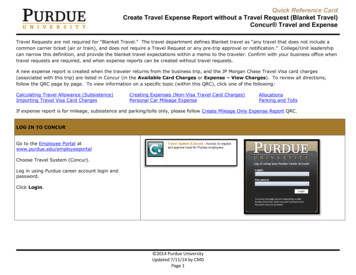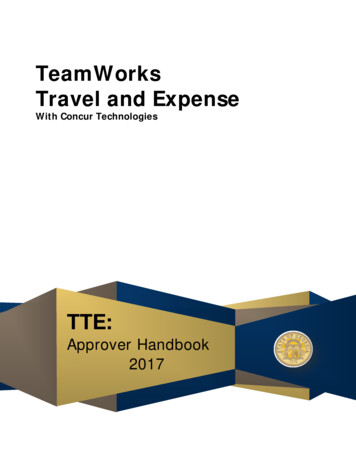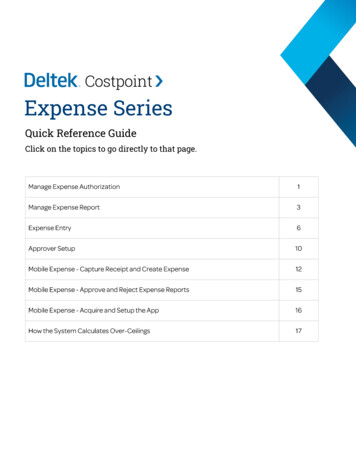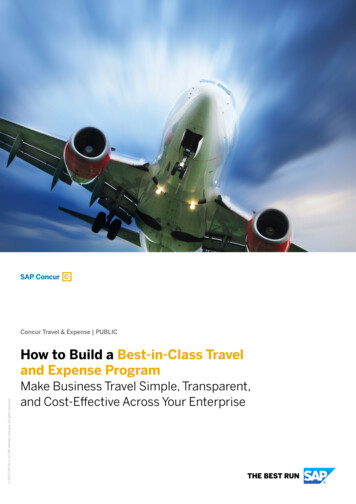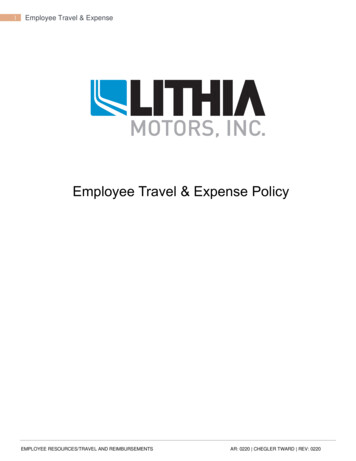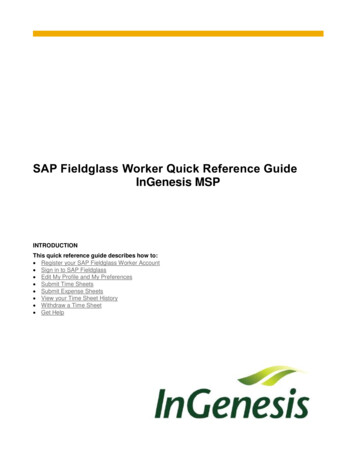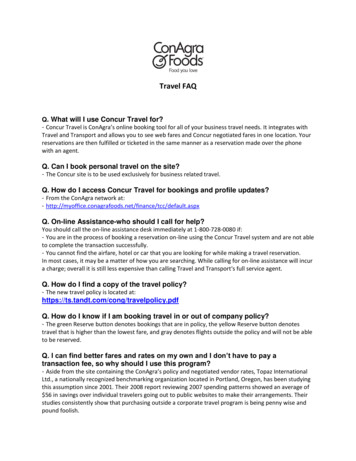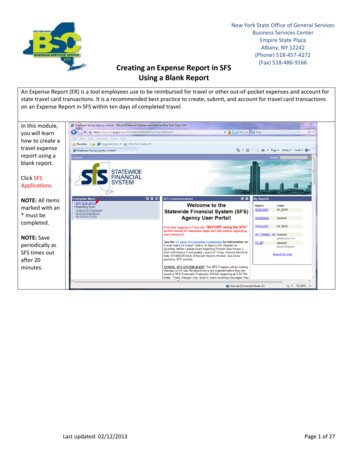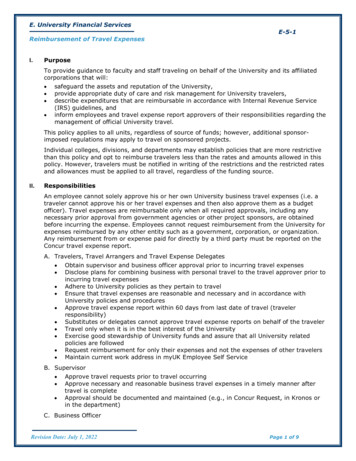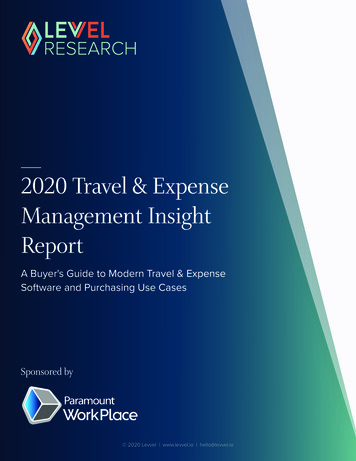
Transcription
2020 Travel & ExpenseManagement InsightReportA Buyer's Guide to Modern Travel & ExpenseSoftware and Purchasing Use CasesSponsored by 2020 Levvel www.levvel.io hello@levvel.io
Table of ContentsIntroduction 3Executive Summary 4Travel & Expense Management AcrossOrganizations 7Travel & Expense Management Software 18Conclusion 27Paramount WorkPlace 28About the Author 31About Levvel 32
Introduction“Uncertain” appropriately describes the current environment around business travel. TheCOVID-19 pandemic has changed Procure-to-Pay (P2P) and Source-to-Settle (S2S), but traveland expense management (TEM) stands out as the most drastically changed function in the backoffice. Airports and hotels sit empty, and many conferences, events, and meetings have shiftedonline. This reality leaves questions around the importance of TEM software, what its future lookslike, and how it can help businesses weather both the pandemic and a post-COVID-19 world.There is still a business case for TEM tools because despite less travel, companies continue tocreate expenses. TEM won’t stop being a priority for organizations, but its use and functionalitywill need to change to keep up with what businesses need. It is up to TEM providers to identifyand adjust to this new business environment and their clients' evolved requirements. Theproviders that successfully met customer demand before the pandemic will stay successful aslong as they continue to prioritize the customer.hello@levvel.io 980.278.3065 2020 Levvel 3
Executive Summary 2020 Levvel 4
Executive SummaryPrimary TakeawaysExecutive SummaryPrimary TakeawaysLevvel's research finds that most organizations are using software in their expense reportingprocess. Solutions built in-house and ERP-based software have popularity, but most organizationsuse a third-party TEM tool. Data indicates that the volume of expense reports has gone downfor many businesses over the last year, and most organizations that have already implementedsoftware are using it less. Still, expense management software remains an attractive option—nearly half of respondent organizations reported that COVID-19 has made automation moreappealing. This indicates that many companies see benefits from using the software beyondsolely managing employee travel.The primary takeaways from this year’s travel and expense research are listed below:»Companies using TEM software typically have a more modern and efficient backoffice. When looking at companies with the same monthly volume, organizations usingTEM software have much quicker expense report cycle times. Most organizations’biggest complaints about their expense process reveal problems with frustrating manualprocesses and delays in routing, approval, and reimbursement. All of these processesare made significantly worse by using a spreadsheet or paper-based TEM system.By using automation tools, organizations are able to achieve more benefits than theirmanual counterparts and build a more efficient process overall. These organizations don’tstop at TEM but also automate other processes. Those using TEM software embracebroader digital transformation across the back-office and are more likely to also havesoftware in processes like accounts payable (AP), accounts receivable (AR), procurement,and sourcing.»Third-party, cloud-based TEM software is the best option for companies looking toautomate expense management. Companies have three options when it comes toautomating their expense reporting process: cloud-based third-party tools, ERP-basedtools, and homegrown ones built using in-house technological resources. Both haveadvantages and disadvantages; however, third-party tools can present less of a technicaland financial commitment than building one internally and tend to have more advancedfeatures than ERP-based tools. Third-party tools added features in reaction to COVID-19,and respondent organizations were more likely to say they used their software morefrequently during the pandemic than respondents using other tools. Third-party softwarepresents the most modern tool for organizations looking for a scalable, high-tech solution.hello@levvel.io 980.278.3065 2020 Levvel 5
Executive SummaryData SummaryData SummaryFor this report, Levvel Research surveyed over 300 professionals involved in or with knowledgeof their organizations’ payments process, as well as travel and expense management policies.The study includes respondents at the team member, analyst, middle management, and executivelevels operating in many different functions, including accounting and finance, human resources,and IT. The respondents also represented a wide range of industries and revenue segments.Sample sizes vary across the charts included herein, due to logic that dictated which questionsthey received.hello@levvel.io 980.278.3065 2020 Levvel 6
Travel & ExpenseManagement AcrossOrganizations 2020 Levvel 7
Travel & Expense Management Across OrganizationsTravel & Expense Management Across OrganizationsOrganizations use a variety of different methods and practices to manage their expense reportingstructure and travel policies, which, in turn, means TEM looks very different across companies.There are several factors that affect this process, including annual revenue, industry, expensereport volume, and percentage of employees traveling regularly. Table 1 shows several importantdata points from respondent organizations to give insight into the TEM process at differentcompanies. This can be used to benchmark against similar organizations and conduct a currentstate analysis.Table 1BENCHMARKSMEMIDDLE %10%8%Spreadsheet51%28%20%Third-party TEM13%35%39%Corporate TMC15%19%28%Booking tool23%53%56%Travel website63%28%17%EXPENSE REPORT METHODBOOKING METHODhello@levvel.io 980.278.3065 2020 Levvel 8
Travel & Expense Management Across OrganizationsPERCENTAGE OF WORKFORCE TRAVELING Pre COVID-19Under 10%30%15%9%10-24%31%33%38%25-49%19%31%28%Over 50%20%22%25%Less than 50092%55%23%500-5,0006%34%49%Over 5,0001%11%28%Increase8%14%27%No 4%4%EXPENSE REPORT VOLUMEEXPENSE REPORT VOLUME CHANGEREMOTE ENVIRONMENTEXPENSE REPORT PROCESSING TIME1 day or less19%6%11%2-5 days54%61%64%1-2 weeks25%29%19%More than 2 weeks2%3%6%hello@levvel.io 980.278.3065 2020 Levvel 9
Travel & Expense Management Across OrganizationsWith the creation of specialized tools and other technological advances, the way businessesmanage their expenses has changed considerably in the past decade. Traditionally, manyorganizations collected paper receipts and filled out expense reports by hand. The expensereporting process has come a long way, as very few organizations can maintain this outdatedmethod. Changes like this and others show the importance of examining how TEM has changedover time. Here are a few of the most notable trends gathered from this year’s study.»A Dip in Expense ReportVolume Has SlowedAdoption and Frequencyof Tool Usage: Surveyresults indicate that thevolume of expense reportsis lower compared to lastyear (Figure 1). Not onlydoes year-over-year datagive evidence of this,but when asked outrighthow their expense reportvolume has changed, mostindicate that volume hasdecreased in the past year.When respondents wereasked why their volume haschanged, unsurprisingly,many pointed to COVID-19as the reason behind thisslowdown.Figure 1Monthly Expense Report Volume & Pandemic’s Effect on Expense Report Volume“On average, how many expense reports would you estimate your organization processesper month?” n 30129%2019202028% 4,9995,000-9,99910,000 or moreTravel & Expense Management Survey, Levvel Research, 2020“How has your organization’s expense report volume changed in thelast year?” n 298Decreased65%Not changedIncreased19%16%Travel & Expense Management Survey, Levvel Research, 2020Because of the pandemic, business travel is at an all-time low, meaning many employeesno longer need to file expenses for plane and train tickets, hotel rooms, or meals onthe road. Levvel Research asserts that for this reason, the previously steady increase inadoption of TEM tools has slowed, and those organizations that already have a tool inplace are using them less frequently (Figure 2 on following page).hello@levvel.io 980.278.3065 2020 Levvel 10
Travel & Expense Management Across OrganizationsThis slow down doesn’t spell out the end for TEM software, but providers must switchtheir approach to prove more value to companies. This could be seen through amessaging change or through the addition of features that let businesses adjust to therealities of a pandemic business environment, and prepare them for life after it.Figure 2Pandemic’s Effect on TEM Tool Usage“How has the COVID-19 pandemic affected your organization’s usage of its TEM tool?” n 199Less frequently58%About the sameMore frequently28%14%Travel & Expense Management Survey, Levvel Research, 2020»TEM Tools Still Have an Important Role to Play: There are many signs that TEM toolsretain importance in helping organizations weather the pandemic and its wake.For example, respondentorganizations indicatedFigure 3that remote work is theRemote Work Shift“Has any part of your organization shifted to a remote environment during COVID-19?” n 301new norm, with nearly90% saying that part of14%their company shifted toa remote environmentYes(Figure 3). Research showsNothat remote work has a86%tendency to exasperateexisting issuesTravel & Expense Management Survey, Levvel Research, 2020hello@levvel.io 980.278.3065 2020 Levvel 11
Travel & Expense Management Across Organizationsfor managing back-office processes, including managing expense reporting. This hasbeen consistent across Levvel’s procurement and AP studies, and TEM is no exception,as many respondents said that COVID-19 had made existing challenges worse. This isparticularly true of organizations that retain a manual expense reporting and approvalstructure. Additionally, it seems that allowing employees more flexibility to work remotelywill be an option that outlasts the pandemic.Therefore, TEM tools remain important for companies looking to modernize their backoffice processes, which many have expressed interest in doing. A large percentage oforganizations have said that COVID-19 has made automation more appealing. Thereis also a sizable group of companies that still have employees traveling, which makescertain TEM features even more appealing, such as the ability to track employees’location history in case of health and safety concerns. More broadly speaking, companiesare looking to improve their spend visibility, reduce fraud risk, and digitize their processes,all of which travel and expense automation enables.»Most Companies Expect aReturn to Normal in Mid-2021:The question of when theworld will return to normal hasbeen top of mind for everyone.There’s hope that, with recentvaccine news, the end is insight. But the questions thatfollow are when businesseswill feel comfortable sendingemployees back into physicaloffices, what that return to theoffice entails, and when therewill be normal business-relatedtravel again. Respondentorganizations believe thattravel volumes reachingpre-pandemic levels will tail areturn to offices (Figure 4).hello@levvel.io 980.278.3065Figure 4Expected Office Return“WhendoesFigure4 your organization expect its workforce to return to the physical office?” n 260Expected Office Return“When does your organization expect its workforce to return to the physical office?” n emoteRemoteNoNoTimelineTimelinehas beenbeenhasgivengiven“When does your organization expect its workforce to return its pre-pandemic work-related“Whendoes yourn 291organization expect its workforce to return its pre-pandemic work-related travel volume?” n 291travelvolume?”6% 4% 11%2020 WinterWinterAtAt FallFallnormalnormal2020 erSummer20212021No NoTimelineTimelinehashasbeenbeengivengivenTravel & Expense Management Survey, Levvel Research, 2020 2020 Levvel 12
Travel & Expense Management Across OrganizationsChallengesClose to 60% of survey respondents indicated that they expect their organization to sendemployees back into offices some time between January and May of 2021. The timeframefor work-related travel is later, with close to 60% of respondents saying that volume willrebound after Spring 2021. TEM providers would be smart to ensure that their tool is“post-pandemic” ready by this date, so that it appeals to businesses that want to takeprecautions for getting employees back out on the road.ChallengesOrganizations see a number of different challenges in managing their expenses. The mostprevalent difficulties are fostered by maintaining a dated process; manual entry and routing ofexpense reports, lengthy approval and reimbursement cycles, and lack of visibility into spendrank as the most demanding aspectsof TEM (Figure 5). Not only are theseFigure 5Travel & Expense Challengeschallenges typically worse amongst“Which of the following best describes your organization's top issues or challenges with itstravel and expense management processes or solutions?” n 301those using simple spreadsheetsManual entry and routing of expense reports41%or paper, but they are also worseLengthy approval and reimbursement cycles32%amongst those using a datedLack of visibility into spend/travel data31%electronic solution, such as a toolHigh spending outside of expense policies26%built and maintained in-house or aHigh overall processing costs24%one built into (or a simple add-on of)Lost expense reports20%an ERP.Those using a homegrown tool arealmost twice as likely to list manualentry and routing as a challenge thanthose using a cloud-based, thirdparty tool. Both ERP and homegrowntool users are more likely tocomplain of an inability to enforcetravel policies.hello@levvel.io 980.278.3065Inability to enforce corporate travel policiesPoor employee productivityHigh volume of expense reporting fraud19%16%14%Travel & Expense Management Survey, Levvel Research, 2020 2020 Levvel 13
Travel & Expense Management Across OrganizationsChallengesThese challenges are reflected in the initiatives companies are taking to improve their expensereporting. Respondent organizations most frequently listed strengthening security, implementingfully digital systems, increasing control and insight into data management, and improving spendvisibility as their top aims for the next year (Figure 6). Guarding against fraud and maverickspend has always been a top goal for organizations looking to improve their expense reporting.However, this year, this focus has emerged as the clear number one focal point for organizationsof all sizes and all automation levels. This may be because the remote-working businessenvironment creates low spend visibility and has companies trying to maintain a culture ofaccountability and trust when it comes to business expenses.Figure 6Back-Office Initiatives“How is your organization prioritizing the following initiatives for improving back-office /business processes over the next 12 months?” n 301Strengthening security for existing tech52%Implementing fully digital systems acrossprocesses42%Increasing control and insight into data39%Improving visibility across spendAutomating more tactical tasksConsolidating disparate technology systemsLeveraging advanced technology35%28%26%25%Travel & Expense Management Survey, Levvel Research, 2020Other goals are much more divided by a number of different factors. Automating tactical tasks isa bigger focus for those using homegrown and ERP-based tools than it is for third-party softwareusers, especially when looking exclusively at those with high expense report volumes. Thissuggests that, while homegrown and ERP tools may work when a company is first looking toautomate, they lose their appeal as a company grows.hello@levvel.io 980.278.3065 2020 Levvel 14
Travel & Expense Management Across OrganizationsBenefitsOn the other hand, implementing fully digital systems and consolidating disparate technologysystems is a goal more common in those using a third-party tool. This group is also more likelyto use an automation tool for tasks other than TEM (i.e., AP, procurement, contracting, etc.) andgenerally has a more favorable view of incorporating software into other processes. In LevvelResearch’s view, this gives software providers evidence that they should focus on ensuring theirtools are able to communicate with other back-office software, either by partnering with othersoftware providers who offer non-TEM software or offering this software themselves. Increasingly,companies are moving away from a siloed approach to their finances and towards one thatconsolidates and provides visibility across all processes.BenefitsAmong respondent organizations using a TEM tool, the most commonly listed benefits (Figure7) are improved expense report accuracy, reduced paper volume, and time saved creatingand processing expense reports. Not only do these benefits make employees jobs easier, butthey also make them more productive and able to focus on the core functions of their jobs. Byreducing time and resources dedicated to expense reporting and increasing their accuracy,automating TEM also saves organizations money and makes them more efficient.Figure 7TEM Software Benefits“What would you say are the top benefits to your organization in using TEM software?” n 164More accurate expense reporting30%Reduced paper volumeQuicker expense report process28%25%23%Improved employee reimbursementReduced unauthorized spending21%21%Reduced processing costsImproved visibility over spendAbility to manage TEM remotelyImproved ability to detect and prevent fraudImproved employee satisfactionImproved ability to enforce travel policyAbility to negotiate vendor discountsReduction in late payment penaltiesIncreased corporate card usage and rebatesImproved regulation compliance (SOX, FASB)20%19%16%15%15%12%11%11%9%Travel & Expense Management Survey, Levvel Research, 2020hello@levvel.io 980.278.3065 2020 Levvel 15
Travel & Expense Management Across OrganizationsBarriersMany of these benefits are much more common amongst certain segments of respondentorganizations, notably travel frequency and percentage of workforce working remotely. Therespondents with a higher percentage of their workforce working remotely were twice as likely tolist reduced unauthorized spend as a benefit than those organizations with a higher percentageemployees working in offices. This bolsters the belief that TEM automation helps organizationsworking remotely reel in maverick spend and gain control over their expenses. Organizationswith a very high percentage of their workforce traveling were over three times more likely to listimproved compliance and nearly two times more likely to list improved travel policy complianceas benefits.BarriersMost companies see that there are advantages to automating TEM. Among companies not usinga solution, lack of understanding on the software, their current process working fine as is, lack ofbuy-in from upper management, and lack of travel/expense report volume are the most frequentlylisted barriers to adoption (Figure 8).Figure 8Barriers to TEM Tool Adoption“What are the primary reasons your organization has not adopted a TEM toolor software tool?” n 136Lack of understandingCurrent processes workLack of upper management support27%22%20%Not enough expense report volumeLack of budgetDon’t see the benefitLack of technical resourcesDon’t see the needCurrent solution is sufficientImplementation/training takes too longOur process is too complexNo executive sponsorship/buy-inThere won’t be an ROIPrefer to manage tasks in a singular softwareWould lose data/information in an upgrade19%17%15%13%13%11%11%10%10%9%9%9%Travel & Expense Management Survey, Levvel Research, 2020hello@levvel.io 980.278.3065 2020 Levvel 16
Travel & Expense Management Across OrganizationsBarriersThe belief that an organization does not have the expense report volume to justify investmentin a specialized tool may be valid, and companies should keep in mind that software providersusually have a volume range their product is designed for. So, while a company may not haveenough monthly expense reports to warrant using one TEM solution, this doesn’t mean there isn’ta tool out there that better suits their needs. Software designed for lower report volume is oftenintended for smaller organizations that do not need advanced functionality. This usually comes ata lower, more flexible price to ensure that companies aren’t paying for complex features they’renot using.Additionally, the volume at which organizations begin to adopt TEM tools may be lower thanmany would speculate. Data shows that once at the 100-499 monthly expense report level, thereis a near 50/50 split on those using a tool versus a manual process. For companies with over1,000 expense reports, almost 80% use a tool (half of them using a third-party tool). The data alsoshows that the higher the volume, the more likely an organization is to use a third-party tool inparticular. Homegrown solutions peak at the 1,000-4,999 monthly report level but decrease afterthat in favor of other software, with 55% of highest volume level using third-party software.Lack of education on this software, the most frequently cited barrier, contributes to andperpetuates several other barriers. For example, without the prerequisite knowledge on what’savailable, companies are likely to believe that there is not a software designed for their situation.They may believe there is not a better alternative to manual processes and that they do not havethe language or information to make a viable pitch for adoption to senior leadership. The key toovercoming many barriers is education on the tools and the enterprise value they bring.hello@levvel.io 980.278.3065 2020 Levvel 17
Travel & ExpenseManagement Software 2020 Levvel 18
Travel & Expense Management SoftwareTypes of SoftwareTravel & Expense Management SoftwareTypes of SoftwareImplementing TEM automation is not as simple as deciding to purchase software. Lack ofunderstanding is a large barrier for a reason—the TEM software marketplace can be confusing.Businesses looking to automate are met with a number of options for software. There arepotential providers and features to take into consideration and entirely distinct categorizations oftools available. Levvel Research breaks the types of TEM tools into three distinct classifications:»ERP-based—simple tools that are included in or added on (with minimal effort) to anorganization’s existing ERP or accounting software»Tools developed by an organization’s in-house technology resources or via collaborationwith a third-party to create a fully custom, homegrown software»Third-party, cloud-based automation software designed specifically for travel and expensemanagementFigure 9 shows what methods organizations use to process expense reports and provides abreakdown in utilization between the three methods.Figure 9Expense Reporting Methods“Which of the following methods is primarily used by employees at your organization to submitexpense reports?” n 3019%13%33%SpreadsheetsThird-party TEM softwareERP-based applicationMail paper receipts16%Homegrown application30%Travel & Expense Management Survey, Levvel Research, 2020hello@levvel.io 980.278.3065 2020 Levvel 19
Travel & Expense Management SoftwareTypes of Software16% of respondent organizations manage their expenses using an ERP-based software. Thiscategory of software presents an easier proposition than homegrown or third-party software. If anorganization already has an ERP or accounting software, adding an expense module is a simplesupplement to existing technology that does not require the cost or time the other tools typicallycome with. Additionally, employees already have training on the software, and the company’sfinancial information is already in the ERP.This category of tool offers a seemingly attractive option for those looking to introducetechnology to a manual process using minimal resources. But ERP-based software is typicallyclunky and difficult to use, which usually results in hesitation from employees to actually utilize thetool. ERP-based tools also have far fewer features than third-party tools, leading Levvel Researchto question how much these tools automate as opposed to simply digitizing. Third-party toolsautomate many of the steps involved in filing and approving expense reports, whereas ERP-basedones simply shift the existing manual process on to the computer, retaining many of the flaws anddelays associated with a paper-based process.Because they lack this level of automation, respondent organizations using ERP-based toolsranked themselves behind in automation to those using third-party software. These samerespondents also said they were more likely to switch in the next year and were less likely to sayimplementation surpassed their pre-automation expectations.A less common way to automate TEM is to build a system internally. This route requires asignificant amount of in-house resources to build and maintain the tool with the hope thatthe result will be a fully customized software designed specifically to address the nuancesand problems of an individual organization. Homegrown tools are typically found in largeorganizations that have highly specialized needs that they feel will not be met in an off-the-shelfsoftware. These types of tools are as powerful and useful as an organization is willing to invest inmaking them.Unfortunately, these tools often lag behind third-party and ERP-based tools. Respondentorganizations using homegrown tools have the slowest report approval cycle times and rankthemselves as the least automated of the three software options. This type of software isdifficult to update, making it much less scalable and dynamic than a third-party tool. Respondentorganizations using homegrown tools used their software less frequently (as a result of COVID-19)than those using other software. They were also more likely to say their software implementationfell short of expectations and were over twice as likely to say their organization was likely tochange tools in the next year. Homegrown tools often lack the basic functionality of a third-partyhello@levvel.io 980.278.3065 2020 Levvel 20
Travel & Expense Management SoftwareCore Travel and Expense Management Featuresoffering, as shown by these respondents listing mobile apps, credit card integrations, reporting,approval, and imaging as low as one-fifth the rate of third-party tool respondents.The most popular option for expense reporting software is a third-party, cloud-based tool. Theseare built by providers with the primary intention of automating as many steps of travel andexpense management as possible. They feature a large number of features and are updatedregularly to make sure the tool is taking advantage of emerging technology and relevant tothe issues seen amongst businesses. In lieu of COVID-19, providers of this software werequicker to add features and adjust pricing than the other software categories. This is why theyhave continued to be used more frequently than homegrown or ERP-based competitors. Thisadaptability and scalability are what part of what make them the best option for businesseslooking to automate TEM.Core Travel and Expense Management FeaturesExpense management is a broad process that encompasses a wide range of spend beyondbooking employee travel. It involves accounting, HR, and even procurement. Many employeesuse this software regularly, and because it involves a number of different functions, advancedTEM tools have a multitude of features. Figure 10 shows the most prevalent features in the TEMsoftware that respondent organizations use. Each feature is then described in detail below.Figure 10TEM Tool Features“Which of the following features are included in your organization’s TEM tool or software?” n 164Expense report approvalExpense report creation and submissionTravel booking51%46%43%Reporting and analyticsExpense capture/receipt imagingReconciliation and reimbursementMobile applicationCredit card integration43%40%35%35%35%33%30%Payment integrationIntegration with other back-office toolsIntegration with ERP/accounting softwarePre-trip authorizationGlobal featuresRegulatory and compliance supportDuty of care/travel risk management28%27%24%17%13%Travel & Expense Management Survey, Levvel Research, 2020hello@levvel.io 980.278.3065 2020 Levvel 21
Travel & Expense Management SoftwareCore Travel and Expense Management FeaturesExpense Creation/Receipt ImagingDefinition and Capabilities: Expense capture is one of the essential features in a TEM tool. Thisfeature enables employees to enter line item expenses into the software. Most tools don’t requireusers to individually type out each expense but allow them to take pictures of their receipts. Onceimaged, expenses are itemized via Optical Character Recognition (OCR). This saves employeesa great deal of time and frustration and frees them up to concentrate
Travel & Expense Management Across Organizations Organizations use a variety of different methods and practices to manage their expense reporting structure and travel policies, which, in turn, means TEM looks very different across companies There are several factors that affect this process, including annual revenue, industry, expense
